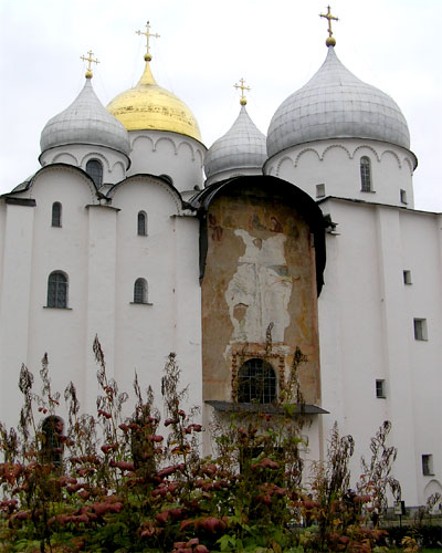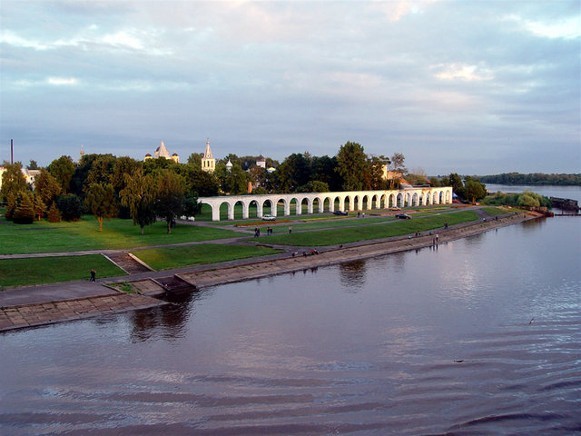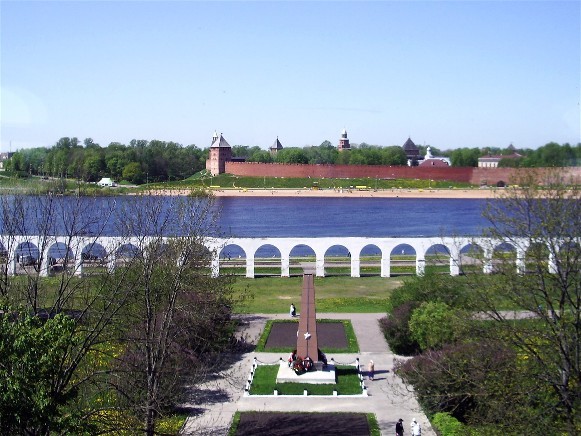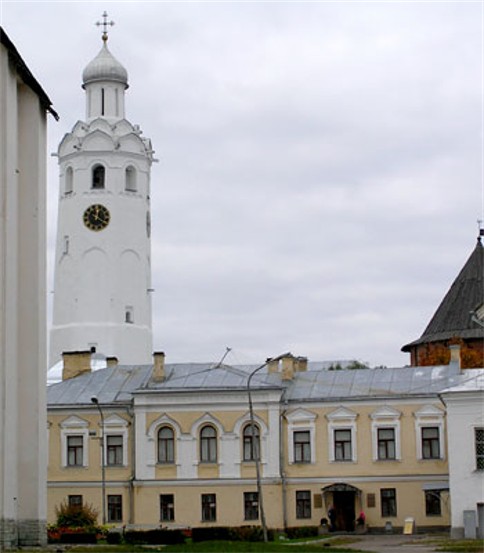Novgorod the Great
Novgorod the Great (Novgorod Velikii). A city-state in northern Kyivan Rus’ from the 12th to the 15th century. According to some scholars (most notably Mykola Kostomarov) the town of Novgorod was established by local Slavs (the Ilmen Slovenes) who had migrated to the north from the middle Dnipro River Basin. According to the Primary Chronicle Varangians led by Riuryk (see Riuryk of Novgorod) arrived there in 862. Novgorod's location on the Varangian route to Byzantium determined its political and economic importance vis-à-vis Kyiv and its relationship with the capital of the Kyivan Rus’ state. Traders from Novgorod did extensive business in Kyiv and had their own district and church there. Kyiv's architecture was copied in Novgorod, as is most evident in the similarity of the Saint Sophia Cathedral in Kyiv and the Saint Sophia Cathedral in Novgorod. The style of the Novgorod chronicles, distinctive in its own right, also displays obvious Kyivan influences. Christianity was introduced in Novgorod via Kyiv. In spite of initial resistance by the local population to the new religion Novgorod soon became an important religious center and eparchial see (the most notable bishop was Luka Zhydiata) within Kyiv metropoly. From 1156 it had its own archbishop.
For the first few centuries Novgorod was ruled by Prince Ihor and his dynasty. Before they became grand princes of Kyiv, both Volodymyr the Great and his son Yaroslav the Wise were princes of Novgorod. Yaroslav was succeeded in Novgorod by his son, Volodymyr. Eventually Novgorod principality came to be ruled by the descendants of Volodymyr Monomakh. Novgorod's political and economic interests, rapid growth, and distance from Kyiv gradually brought about local opposition to Kyivan rule. Such opposition was evident in the 11th century, when Yaroslav the Wise refused to pay tribute to his father in Kyiv and Kosniatin (Kostiantin) Dobrynich (the son of Dobrynia, Yaroslav's cousin and the viceroy in Novgorod) pursued an obviously anti-Kyivan course of action. Vsevolod Mstyslavych, Monomakh's grandson and the son of Mstyslav I Volodymyrovych, was the last prince of the Kyivan dynasty in Novgorod (1118–36) to interfere in Novgorod's affairs. The city revolted against his rule and achieved its political independence as a feudal republic in 1136. The supreme governing authority of the city became the veche (Ukrainian: viche), and the posadnik became an elected mayor rather than a viceroy appointed by the prince. In practice the city was run by the local boyars and wealthy merchants. The arrangement was formalized in the 14th century, when a council of representatives of the most powerful boyar families chaired by the archbishop was established to administer the city.
The Tatar invasion of Europe in 1239–40 did not reach Novgorod the Great, but the city was compelled to recognize the suzerainty of the Golden Horde and to pay tribute to its khan. Relative independence from the Tatar yoke allowed the city to develop and prosper considerably by exploiting the neighboring satellites and colonies and engaging in European trade, particularly with the Hanseatic League. A greater threat to the republic in the long term emerged with the rise of Muscovy. Novgorod attempted to stem the growing Muscovite influence and encroachments by allying itself with the Grand Duchy of Lithuania and even electing a Lithuanian-Ruthenian appanage prince from Kyiv, Mykhailo Olelkovych, as its prince in 1470. Those efforts ultimately proved fruitless, as the Muscovite prince Ivan III annexed much of the republic's territory in 1471 and then forced the city, through sheer terror, to recognize Moscow's suzerainty in 1478.
BIBLIOGRAPHY
The Chronicle of Novgorod, 1016–1471, trans R. Michell and N. Forbes (London 1914; 2nd edn, Hattiesburg, Miss 1970)
Likhachev, D. Novgorod Velikii: Ocherk istorii kul’tury Novgoroda XI–XVII vv. (Moscow–Leningrad 1961)
Ianin, V. Novgorodskie posadniki (Moscow 1962)
Podvigina, N. Ocherki sotsial’no-ekonomicheskoi i politicheskoi istorii Novgoroda Velikogo v XII–XIII vv. (Moscow 1976)
Birnbaum, H. Lord Novgorod the Great: Essays in the History and Culture of a Medieval City-State (Columbus, Ohio 1981)
Rybakov, B. Kievskaia Rus’ i russkie kniazhestva XII–XIII vv. (Moscow 1982)
Mykhailo Zhdan
[This article originally appeared in the Encyclopedia of Ukraine, vol. 3 (1993).]

.jpg)
.jpg)




.jpg)